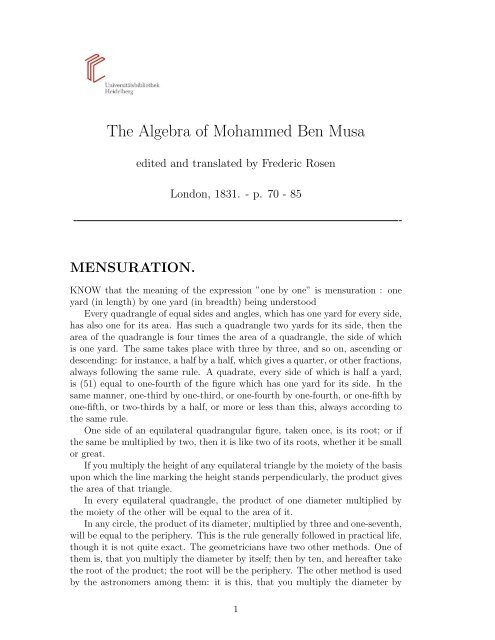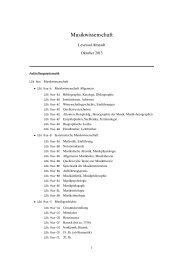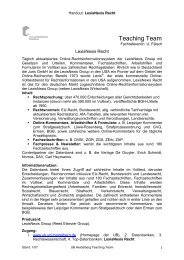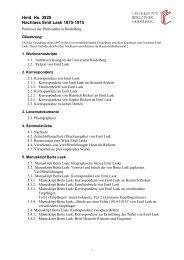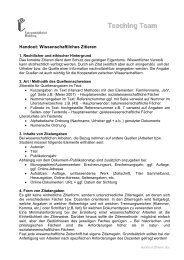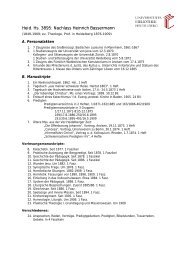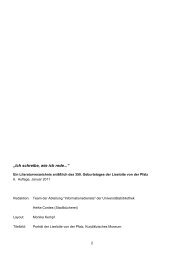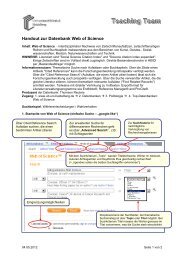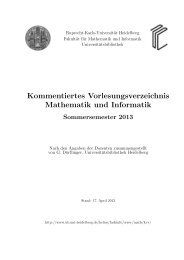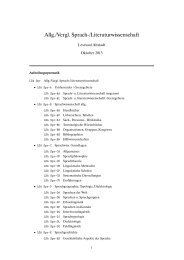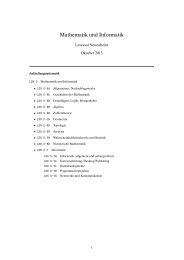The Algebra of Mohammed Ben Musa
The Algebra of Mohammed Ben Musa
The Algebra of Mohammed Ben Musa
You also want an ePaper? Increase the reach of your titles
YUMPU automatically turns print PDFs into web optimized ePapers that Google loves.
<strong>The</strong> <strong>Algebra</strong> <strong>of</strong> <strong>Mohammed</strong> <strong>Ben</strong> <strong>Musa</strong><br />
MENSURATION.<br />
edited and translated by Frederic Rosen<br />
London, 1831. - p. 70 - 85<br />
KNOW that the meaning <strong>of</strong> the expression ”one by one” is mensuration : one<br />
yard (in length) by one yard (in breadth) being understood<br />
Every quadrangle <strong>of</strong> equal sides and angles, which has one yard for every side,<br />
has also one for its area. Has such a quadrangle two yards for its side, then the<br />
area <strong>of</strong> the quadrangle is four times the area <strong>of</strong> a quadrangle, the side <strong>of</strong> which<br />
is one yard. <strong>The</strong> same takes place with three by three, and so on, ascending or<br />
descending: for instance, a half by a half, which gives a quarter, or other fractions,<br />
always following the same rule. A quadrate, every side <strong>of</strong> which is half a yard,<br />
is (51) equal to one-fourth <strong>of</strong> the figure which has one yard for its side. In the<br />
same manner, one-third by one-third, or one-fourth by one-fourth, or one-fifth by<br />
one-fifth, or two-thirds by a half, or more or less than this, always according to<br />
the same rule.<br />
One side <strong>of</strong> an equilateral quadrangular figure, taken once, is its root; or if<br />
the same be multiplied by two, then it is like two <strong>of</strong> its roots, whether it be small<br />
or great.<br />
If you multiply the height <strong>of</strong> any equilateral triangle by the moiety <strong>of</strong> the basis<br />
upon which the line marking the height stands perpendicularly, the product gives<br />
the area <strong>of</strong> that triangle.<br />
In every equilateral quadrangle, the product <strong>of</strong> one diameter multiplied by<br />
the moiety <strong>of</strong> the other will be equal to the area <strong>of</strong> it.<br />
In any circle, the product <strong>of</strong> its diameter, multiplied by three and one-seventh,<br />
will be equal to the periphery. This is the rule generally followed in practical life,<br />
though it is not quite exact. <strong>The</strong> geometricians have two other methods. One <strong>of</strong><br />
them is, that you multiply the diameter by itself; then by ten, and hereafter take<br />
the root <strong>of</strong> the product; the root will be the periphery. <strong>The</strong> other method is used<br />
by the astronomers among them: it is this, that you multiply the diameter by<br />
1
sixty-two thousand eight hundred and thirty-two and then divide the product by<br />
twenty thousand; the quotient is the periphery. Both methods come very nearly<br />
to the same effect. 1<br />
If you divide the periphery by three and one-seventh, the quotient is the<br />
diameter.<br />
<strong>The</strong> area <strong>of</strong> any circle will be found by multiplying the moiety <strong>of</strong> the circumference<br />
by the moiety <strong>of</strong> the diameter; since, in every polygon <strong>of</strong> equal sides and<br />
angles, such as triangles, quadrangles, pentagons, and so on, the area is found by<br />
multiplying the moiety <strong>of</strong> the circumference by the moiety <strong>of</strong> the diameter <strong>of</strong> the<br />
middle circle that may be drawn through it.<br />
If you multiply the diameter <strong>of</strong> any circle by itself, and subtract from the<br />
product one-seventh and half one-seventh <strong>of</strong> the same, then the remainder is<br />
equal to the area <strong>of</strong> the circle. This comes very nearly to the same result with<br />
the method given above, 2<br />
Every part <strong>of</strong> a circle may be compared to a bow. It must be either exactly<br />
equal to half the circumference, or less or greater than it. This may be ascertained<br />
by the arrow <strong>of</strong> the bow. When this becomes equal to the moiety <strong>of</strong> the chord,<br />
then the arc is exactly the moiety <strong>of</strong> the circumference: is it shorter than the<br />
moiety <strong>of</strong> the chord, then the bow is less than half the circumference; is the<br />
arrow longer than half the chord, then the bow comprises more than half the<br />
circumference.<br />
If you want to ascertain the circle to which it belongs, multiply the moiety<br />
<strong>of</strong> the chord by itself, divide it by the arrow, and add the quotient to the arrow,<br />
the sum is the diameter <strong>of</strong> the circle to which this bow belongs.<br />
If you want to compute the area <strong>of</strong> the bow, multiply the moiety <strong>of</strong> the<br />
diameter <strong>of</strong> the circle by the moiety <strong>of</strong> the bow, and keep the product in mind.<br />
<strong>The</strong>n subtract the arrow <strong>of</strong> the bow from the moiety <strong>of</strong> the diameter <strong>of</strong> the circle,<br />
if the bow is smaller than half the circle; or if it is greater than half the circle,<br />
subtract half the diameter <strong>of</strong> the circle from the arrow <strong>of</strong> the bow. Multiply the<br />
remainder by the moiety <strong>of</strong> the chord <strong>of</strong> the bow, and subtract the product from<br />
that which you have kept in mind if the bow is smaller than the moiety <strong>of</strong> the<br />
circle, or add it thereto if the bow is greater than half the circle. <strong>The</strong> sum after<br />
the addition, or the remainder after the subtraction, is the area <strong>of</strong> the bow.<br />
<strong>The</strong> bulk <strong>of</strong> a quadrangular body will be found by multiplying the length by<br />
the breadth, and then by the height.<br />
If it is <strong>of</strong> another shape than the quadrangular (for instance, circular or triangular),<br />
so, however, that a line representing its height may stand perpendicularly<br />
1<strong>The</strong> three formulas are,<br />
1st, 3 1<br />
7d = p i.e. 3.1428d<br />
2d, √ 10d2 = p i.e. .16227d<br />
3d, d×62832 = p i.e.3.1416d<br />
20000<br />
2 d <strong>The</strong> area <strong>of</strong> a circle whosse diameter is d is π 2<br />
2<br />
4<br />
22 = 7×4d2 = (1 − 1 1<br />
7 − 2×7 )d2 .
on its basis, and yet be parallel to the sides, you must calculate it by ascertaining<br />
at first the area <strong>of</strong> its basis. This, multiplied by the height, gives the bulk <strong>of</strong> the<br />
body.<br />
Cones and pyramids, such as triangular or quadrangular ones, are computed<br />
by multiplying one-third <strong>of</strong> the area <strong>of</strong> the basis by the height.<br />
Observe, that in every rectangular triangle the two short sides, each multiplied<br />
by itself and the products added together, equal the product <strong>of</strong> the long side<br />
multiplied by itself.<br />
<strong>The</strong> pro<strong>of</strong> <strong>of</strong> this is the following. We draw a quadrangle, with equal sides<br />
and angles ABCD. We divide the line AC into two moieties in the point H,<br />
from which we draw a parallel to the point R. <strong>The</strong>n we divide, also, the line<br />
AB into two moieties at the point T , and draw a parallel to the point G. <strong>The</strong>n<br />
the quadrate ABCD is divided into four quadrangles <strong>of</strong> equal sides and angles,<br />
and <strong>of</strong> equal area; namely., the squares AK, CK, BK, and DK. Now, we draw<br />
from the point H to the point T a line which divides the quadrangle AK into<br />
two equal parts: thus there arise two triangles from the quadrangle, namely, the<br />
triangles AT H and HKT . We know that AT is the moiety <strong>of</strong> AB, and that AH<br />
is equal to it, being the moiety <strong>of</strong> AC; and the line T H joins them opposite the<br />
right angle. In the same manner we draw lines from T to R, and from R to G,<br />
and from G to H. Thus from all the squares eight equal triangles arise, four <strong>of</strong><br />
which must, consequently, be equal to the moiety <strong>of</strong> the great quadrate AD. We<br />
know that the line AT multiplied by itself is like the area <strong>of</strong> two triangles, and<br />
AK gives the area <strong>of</strong> two triangles equal to them; the sum <strong>of</strong> them is therefore<br />
four triangles. But the line HT , multiplied by itself, gives likewise the area <strong>of</strong><br />
four such triangles. We perceive, therefore, that the sum <strong>of</strong> AT multiplied by<br />
itself, added to AH multiplied by itself, is equal to T H multiplied by itself. This<br />
is the observation which we were desirous to elucidate. Here is the figure to it:<br />
Quadrangles are <strong>of</strong> five kinds: firstly, with right angles and equal sides; secondly,<br />
with right angles and unequal sides; thirdly, the rhombus, with equal sides<br />
and unequal angles; fourthly, the rhomboid, the length <strong>of</strong> which differs from its<br />
breadth, and the angles <strong>of</strong> which are unequal, only that the two long and the<br />
two short sides are respectively <strong>of</strong> equal length; fifthly, quadrangles with unequal<br />
sides and angles.<br />
First kind. – <strong>The</strong> area <strong>of</strong> any quadrangle with equal sides and right angles,<br />
3
or with unequal sides and right angles, may be. found by multiplying the length<br />
by the breadth. <strong>The</strong> product is the area. For instance: a quadrangular piece <strong>of</strong><br />
ground, every side <strong>of</strong> which has five yards, has an area <strong>of</strong> five-and-twenty square<br />
yards. Here is its figure<br />
Second kind. – A quadrangular piece <strong>of</strong> ground, the two long sides <strong>of</strong> which<br />
are <strong>of</strong> eight yards each, while the breadth is six.. You find the area by multiplying<br />
six by eight, which yields forty-eight yards. Here is the figure to it:<br />
Third kind, the Rhombus. – Its sides are equal: let each <strong>of</strong> them be five, and<br />
let its diagonals be, the one eight and the other six yards. You may then compute<br />
the area, either from one <strong>of</strong> the diagonals, or from both. As you know them both,<br />
you multiply the one by the moiety <strong>of</strong> the other, the product is the area: that is<br />
to say, you multiply eight by three, or six by four; this yields twenty-four yards,<br />
which is the area. If you know only one <strong>of</strong> the diagonals, then you are aware, that<br />
there are two triangles, two sides <strong>of</strong> each <strong>of</strong> which have every one five yards, while<br />
the third is the diagonal. Hereafter you can make the computation according to<br />
the rules for the triangles. 3 This is the figure:<br />
<strong>The</strong> fourth kind, or Rhomboid, is computed in the same way as the rhombus.<br />
Here is the figure to it:<br />
3 ′ dd If the two diagonals are d and d , and the side s, the area <strong>of</strong> the rhombus is ′<br />
<br />
2<br />
s2 − d2<br />
4 .<br />
4<br />
= d ×
<strong>The</strong> other quadrangles are calculated by drawing a diagonal, and computing<br />
them as triangles.<br />
Triangles are <strong>of</strong> three kinds, acute-angular, obtuse-angular, or rectangular.<br />
<strong>The</strong> peculiarity <strong>of</strong> the rectangular triangle is, that if you multiply each <strong>of</strong> its two<br />
short sides by itself, and then add them together, their sum will be equal to the<br />
long side multiplied by itself. <strong>The</strong> character <strong>of</strong> the acute-angled triangle is this :<br />
if you multiply every one <strong>of</strong> its two short sides by itself, and add the products,<br />
their sum is more than the long side alone multiplied by itself. <strong>The</strong> definition<br />
<strong>of</strong> the obtuse-angled triangle is this : if you multiply its two short sides each by<br />
itself, and then add the products, their sum is less than the product <strong>of</strong> the long<br />
side multiplied by itself.<br />
<strong>The</strong> rectangular triangle has two cathetes and an hypotenuse. It may be<br />
considered as the moiety <strong>of</strong> a quadrangle. You find its area by multiplying one<br />
<strong>of</strong> its cathetes by the moiety <strong>of</strong> the other. <strong>The</strong> product is the area.<br />
Examples. – A rectangular triangle; one cathete being (58) six yards, the<br />
other eight, and the hypotenuse ten. You make the computation by multiplying<br />
six by four: this gives twenty-four, which is the area. Or if you prefer, you may<br />
also calculate it by the height, which rises perpendicularly from the longest side<br />
<strong>of</strong> it: for the two short sides may themselves be considered as two heights. If you<br />
prefer this, you multiply the height by the moiety <strong>of</strong> the basis. <strong>The</strong> product is<br />
the area. This is the figure:<br />
Second kind. – An equilateral triangle with acute angles, every side <strong>of</strong> which is<br />
ten yards long. Its area may be ascertained by the line representing its height and<br />
the point from which it rises. 4 Observe, that in every isosceles triangle, a line to<br />
represent the height drawn to the basis rises from the latter in a right angle, and<br />
the point from which it proceeds is always situated in the midst <strong>of</strong> the basis; if, on<br />
the contrary, the two sides are not equal, then this point never lies in the middle<br />
<strong>of</strong> the basis. In the case now before us we perceive, that towards whatever side we<br />
may draw the line which is to represent the height, it must necessarily always fall<br />
in the middle <strong>of</strong> it, where the length <strong>of</strong> the basis is five. Now the height will be<br />
4 <strong>The</strong> height <strong>of</strong> the equilateral triangle whose side is 10, is √ 10 2 − 5 2 = √ 75 and the area <strong>of</strong><br />
the triangle is 5 √ 75 = 25 √ 3<br />
5
ascertained thus. You multiply five by itself; then multiply one <strong>of</strong> the sides, that<br />
is ten, by itself, which gives a hundred. Now you subtract from this the product<br />
<strong>of</strong> five multiplied by itself, which is twenty-five. <strong>The</strong> remainder is seventy-five, the<br />
root <strong>of</strong> which is the height. This is a line common to two rectangular triangles.<br />
If you want to find the area, multiply the root <strong>of</strong> seventy-five by the moiety <strong>of</strong><br />
the basis, which is five. This you perform by multiplying at first five by itself;<br />
then you may say, that the root <strong>of</strong> seventy-five is to be multiplied by the root <strong>of</strong><br />
twenty-five. Multiply seventy-five by twenty-five. <strong>The</strong> product is one thousand<br />
eight hundred and seventy-five ; take its root, it is the area: it is forty-three and<br />
a little. 5 Here is the figure:<br />
<strong>The</strong>re are also acute-angled triangles, with different sides. <strong>The</strong>ir area will be<br />
found by means <strong>of</strong> the line representing the height and the point from which it<br />
proceeds. Take, for instance, a triangle, one side <strong>of</strong> which is fifteen yards, another<br />
fourteen, and the third thirteen yards. In order to find the point from which the<br />
line marking the height does arise, you may take for the basis any side you choose;<br />
e. g. that which is fourteen yards long. <strong>The</strong> point from which the line representing<br />
the height does arise, lies in this basis at an unknown distance from either <strong>of</strong> the<br />
two other sides. Let us try to find its unknown distance from the side which is<br />
thirteen yards long. Multiply this distance by itself; it becomes an [unknown]<br />
square. Subtract this from thirteen multiplied by itself; that is, one hundred<br />
and sixty-nine. <strong>The</strong> remainder is one hundred and sixty-nine less a square. <strong>The</strong><br />
root from this is the height. <strong>The</strong> remainder <strong>of</strong> the basis is fourteen less thing.<br />
We multiply this by itself; it becomes one hundred and ninety-six, and a square<br />
less twenty-eight things. We subtract this from fifteen multiplied by itself; the<br />
remainder is twenty-nine dirhems and twenty-eight things less one square. <strong>The</strong><br />
root <strong>of</strong> this is the height. As, therefore, the root <strong>of</strong> this is the height, and the root<br />
<strong>of</strong> one hundred and sixty-nine less square is the height likewise, we know that,<br />
they both are the same. 6 Reduce them, by removing square against square,<br />
since both are negatives. <strong>The</strong>re remain twenty-nine [dirhems] plus twenty-eight<br />
things, which are equal to one hundred and sixty-nine. Subtract now twenty-nine<br />
from one hundred and sixty-nine. <strong>The</strong> remainder is one hundred and forty, equal<br />
5 <strong>The</strong> root is 43.3 +<br />
6 √ 169 − x 2 = 29 + 28x − x 2<br />
163 = 20 + 28x<br />
140 = 28x<br />
5 = x<br />
6
to twenty-eight things. One thing is, consequently, five. This is the distance<br />
<strong>of</strong> the said point from the side <strong>of</strong> thirteen yards. <strong>The</strong> complement <strong>of</strong> the basis<br />
towards the other side is nine. Now in order to find the height, you multiply five<br />
by itself, and subtract it from the contiguous side, which is thirteen, multiplied<br />
by itself. <strong>The</strong> remainder is one hundred and forty-four. Its root is the height. It<br />
is twelve. <strong>The</strong> height forms always two right angles with the basis, and it is called<br />
the column, on account <strong>of</strong> its standing perpendicularly. Multiply the height into<br />
half the basis, which is seven. <strong>The</strong> product is eighty-four, which is the area. Here<br />
is the figure :<br />
<strong>The</strong> third species is that <strong>of</strong> the obtuse-angled triangle with one obtuse angle<br />
and sides <strong>of</strong> different length. For instance, one side being six, another five, and<br />
the third nine. <strong>The</strong> area <strong>of</strong> such a triangle will be found by means <strong>of</strong> the height<br />
and <strong>of</strong> the point from which a line representing the same arises. This point can,<br />
within such a triangle, lie only in its longest side. Take therefore this as the basis<br />
: for if you choose to take one <strong>of</strong> the short sides as the basis, then this point<br />
would fall beyond the triangle. You may find the distance <strong>of</strong> this point, and the<br />
height, in the same manner, which I have shown in the acute-angled triangle; the<br />
whole computation is the same. Here is the, figure;<br />
We have above treated at length <strong>of</strong> the circles, <strong>of</strong> their qualities and their<br />
computation. <strong>The</strong> following is an example: If a circle has seven for its diameter,<br />
then it has twenty-two for its circumference. Its area you find in the following<br />
manner: Multiply the moiety <strong>of</strong> the diameter, which Is three and a half, by the<br />
moiety <strong>of</strong> the circumference, which Is eleven. <strong>The</strong> product is thirty-eight and a<br />
half, which is the area. Or you may also multiply the diameter, which is seven, by<br />
itself: this is forty-nine; subtracting herefrom one-seventh and half one-seventh,<br />
which is ten and a half, there remain thirty-eight and a half, which is the area.<br />
Here is the figure:<br />
7
If some one inquires about the bulk <strong>of</strong> a pyramidal pillar, its base being<br />
four yards by four yards, its height ten yards, and the dimensions at its upper<br />
extremity two yards by two yards; then we know already that every pyramid is<br />
decreasing towards its top, and that one-third <strong>of</strong> the area <strong>of</strong> its basis, multiplied<br />
by the height, gives its bulk. <strong>The</strong> present pyramid has no top. We must therefore<br />
seek to ascertain what is wanting in its height to complete the top. We observe,<br />
that the proportion <strong>of</strong> the entire height to the ten, which we have now before<br />
us, is equal to the proportion <strong>of</strong> four to two. Now as two is the moiety <strong>of</strong> four,<br />
ten must likewise be the moiety <strong>of</strong> the entire height, and the whole height <strong>of</strong> the<br />
pillar must be twenty yards; At present we take one-third <strong>of</strong> the area <strong>of</strong> the basis,<br />
that is, five and one-third, and multiply it by the lengthj which is twenty. <strong>The</strong><br />
product is one hundred and six yards and two-thirds. Herefrom we must then<br />
subtract the piece, which we have added in order to complete the pyramid. This<br />
we perform by multiplying one and one-third, which is one-third <strong>of</strong> the product<br />
<strong>of</strong> two by two, by ten : this gives thirteen and a third. This is the piece which we<br />
have added in order to complete the pyramid. Subtracting this from one hundred<br />
and six yards and two-thirds, there remain ninety-three yards and one-third : and<br />
this is the bulk <strong>of</strong> the mutilated pyramid. This is the figure:<br />
If the pillar has a circular basis, subtract one-seventh and half a seventh from<br />
the product <strong>of</strong> the diameter multiplied by itself, the remainder is the basis. If<br />
some one says: ”<strong>The</strong>re is a triangular piece <strong>of</strong> land, two <strong>of</strong> its sides having ten<br />
yards each, and the basis twelve; what must be the length <strong>of</strong> one side <strong>of</strong> a quadrate<br />
situated within such a triangle?” the solution is this. At first you ascertain the<br />
height <strong>of</strong> the triangle, by multiplying the moiety <strong>of</strong> the basis, (which is six) by<br />
itself, and subtracting the product, which is thirty-six, from one <strong>of</strong> the two short<br />
sides multiplied itself, which is one hundred; the remainder is sixty-four: take the<br />
root from this; It is eight. This is the height <strong>of</strong> the triangle. Its area is, therefore,<br />
forty-eight yards: such being the product <strong>of</strong> the height multiplied by the moiety<br />
8
<strong>of</strong> the basis, which is six. Now we assume that one side <strong>of</strong> the quadrate inquired<br />
for is thing. We multiply it by itself; thus it becomes a square, which we keep<br />
in mind. We know that there must remain two triangles on the two sides <strong>of</strong> the<br />
quadrate, and one above it. <strong>The</strong> two triangles on both sides <strong>of</strong> it are equal to<br />
each other : both having the same height and being rectangular. You find their<br />
area by multiplying thing by six less half a thing, which gives six things less half<br />
a square. This is the area <strong>of</strong> both the triangles on the two sides <strong>of</strong> the quadrate<br />
together. <strong>The</strong> area <strong>of</strong> the upper triangle will be found by multiplying eight less<br />
thing, which is the height, by half one thing. <strong>The</strong> product is four things less half<br />
a square. This altogether is equal to the area <strong>of</strong> the quadrate plus that <strong>of</strong> the<br />
three triangles: or, ten things are equal to forty-eight, which is the area <strong>of</strong> the<br />
great triangle. One thing from this is four yards and four-fifths <strong>of</strong> a yard; and<br />
this is the length <strong>of</strong> any side <strong>of</strong> the quadrate. Here is the figure:<br />
9


